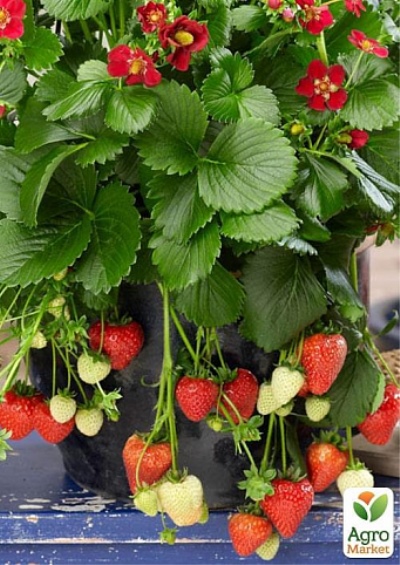
- Authors: ABZ seeds company
- Taste: sweet
- The size: average
- Yield rate: high
- Repairability: Yes
- Ripening terms: early
- Appointment: fresh consumption, processing (juice, jam, jam, etc.)
- Description of the bush: small, compact
- Berry color: Dark red
- Winter hardiness: winter hardy
Strawberry Tristan belongs to the first generation F1 hybrids. The variety was bred by breeders of the company ABZ Seeds, located in the Netherlands. In Russia, in European countries and in the United States, this hybrid is not yet as popular as other remontant strawberry varieties. However, gardeners note its unconditional decorative effect, productivity and resistance to various diseases.
Description of the variety
The Tristan strawberry variety is characterized by compact small bushes 20-30 cm high. The leaves are bright green, toothed, of medium size. The flowers have an unusual dark pink color. Tristan belongs to remontant varieties, so it forms very little mustache. The peculiarities of this strawberry are the ampelling and exceptional decorativeness of the whole plant.
Ripening terms
Strawberry Tristan blooms actively in mid-May, so the ripening dates for the berries are also early. Like all remontant varieties, it is characterized by a long fruiting period. The first berries appear in mid-June, and the next ones ripen all summer until the first autumn frosts. Thus, the variety bears fruit for almost 4 months.
Yield
This strawberry variety has a high yield. It is 700-900 g per bush, and about 5 kg of berries can be harvested from 1 m2 for the whole season. Good yield is achieved by long-term fruiting and by the fact that many berries are formed on the daughter rosettes.
Berries and their taste
The fruits of the Tristan variety are dark red in color with a glossy sheen. They are elongated, conical in shape. The berries are medium in size, the weight of one fruit is about 30 g. The pulp is dense and juicy, the skin is strong. The berries taste sweet, dessert, have a delicate pleasant aroma.
Berries of the variety are suitable for eating both fresh and for processing (preserves, jams, juices). The fruits are well stored and transportable. Unsurprisingly, the Tristan variety is grown commercially for the sake of sales. High marketability is inherent in berries.
Growing features
Despite its decorative effect, Tristan strawberry is an easy-to-care variety. He needs an average intensity of watering, and the variety has a high drought tolerance. It is considered a frost-resistant plant, but in the northern regions it requires an obligatory shelter for the winter. Like many ampelous crops, Tristan can be grown with equal success both in the beds and in pots, flowerpots, balcony boxes.




Site selection and soil preparation
Strawberry Tristan loves calm, well-lit areas, but can also bear fruit in partial shade. It is suitable for ordinary fertile soil without stagnant water. Seedlings are usually planted in May. Two weeks before planting, it is good to add rotted manure or compost to the soil. It is recommended not to deepen the core of the plant and keep the distance between the bushes at 20 cm, and in the aisles - 35 cm.

Pollination
This strawberry variety has bisexual flowers. This means that it is characterized by self-pollination. No additional measures for pollination of flowers are necessary.

One of the important techniques in strawberry care is feeding. Regular fertilization guarantees a rich harvest. There are several different ways to feed strawberries, and each of them is designed for a specific period of plant development. During flowering, fruiting and after it, feeding should be different.

Diseases and pests
The Tristan variety is characterized by high resistance to brown and white spots and to root rot. But young plants can get sick with anthracnose and late blight of roots. In order to prevent these diseases, it is recommended to treat strawberry bushes before flowering with fungicides, for example, Bordeaux liquid or Signum.
Of the pests, Tristan strawberries are sometimes affected by weevils, aphids, and garden mites. To prevent their attacks, an infusion of onion peels and garlic is often used, sprinkling the bushes in the evening or on a cloudy day. In extreme cases, insecticides "Aktara", "Fitoverm" are used. It is important to know that after using them, you cannot pick berries for 3-5 days.

Strawberries are often subject to many dangerous diseases that can seriously undermine its condition. Among the most common are powdery mildew, gray mold, brown spot, anthracnose, and verticillosis. Before buying a variety, you need to inquire about its disease resistance.
Reproduction
The simplest method of reproduction by dividing the bush is not suitable for the Tristan variety, since this reduces the decorative effect of the plant. It is problematic to breed this strawberry with a mustache, because they are practically not formed. Breeding the Tristan variety with seeds is optimal.However, it should be borne in mind that self-collected seed will not give a good harvest, the seeds must be bought.
It is recommended to sow seeds in late February - early March, it is better to plant them immediately in a disposable container, because the variety does not like transplanting. The soil can be bought ready-made, or made independently from turf, black peat, humus, sand in a ratio of 2: 1: 1: 1. Seeds are carefully placed on top of the soil and lightly sprinkled, then moistened with a spray bottle, covered with foil and placed in a warm place. Spraying and airing are periodically carried out until 3 leaves grow on the shoots, after which the film is removed. In the 6-leaf phase, strawberries can be planted outdoors.



















































































